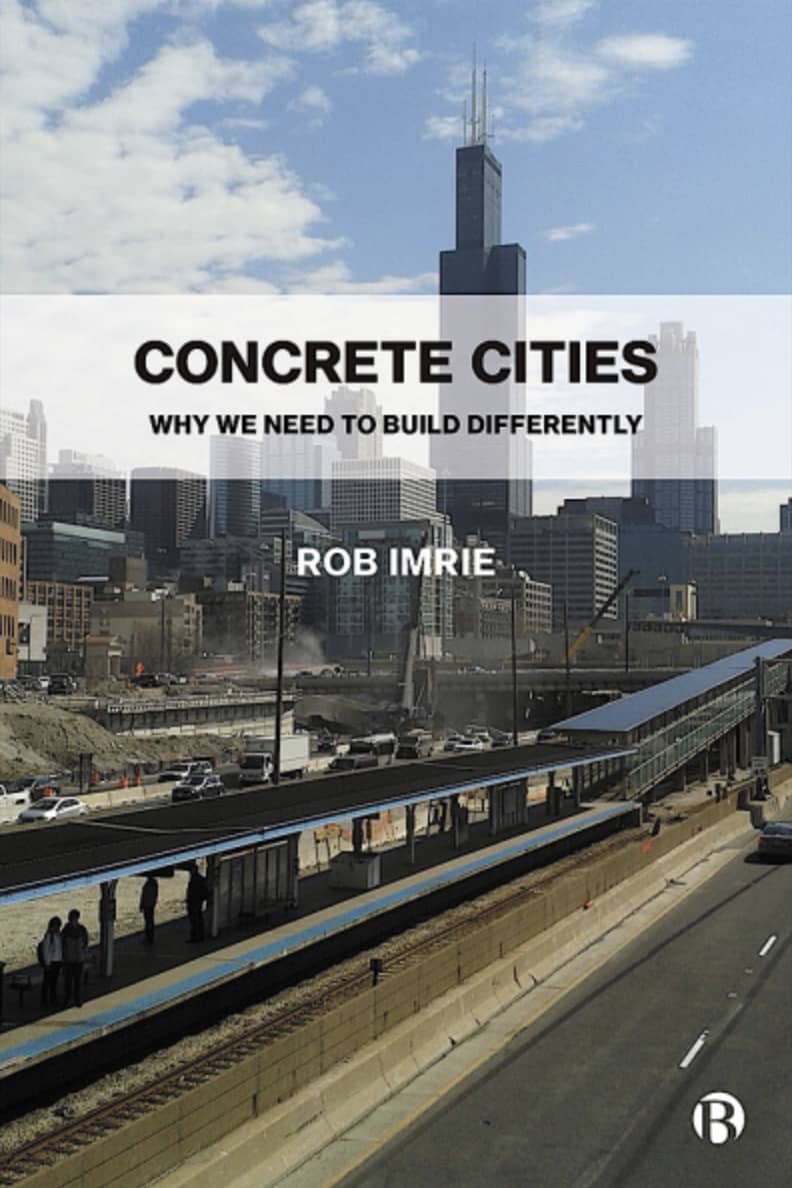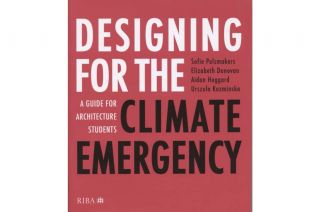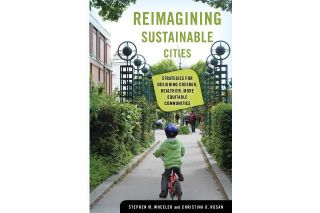
www.buildingsandcities.org/insights/reviews/concrete-cities.html
Concrete Cities: Why We Need to Build Differently
By Rob Imrie. Bristol University Press, 2021, ISBN 9781529220520

Pryor Placino (Western Sydney University and Thammasat University) and Katherine Gibson (Western Sydney University) applaud this significant book which offers a profound, urgent critique of the construction economy and a vision for a new regime.
Rob Imrie's book puts the modern building industry's uncaring nature under critical scrutiny. He asks: why have the construction and property industries worsened the quality of life in many urban spaces instead of making them livable? Construction projects across the globe have become expansive and disruptive. They are major contributors to air and noise pollution, voraciously consume mineral-based raw materials and fossil fuels, and selectively support the needs of able-bodied people over others. As the author emphatically points out, these unfortunate situations need not prevail.
Buildings that care demand not only revitalized material design, but also ways of redefining, rearranging, and radically transforming the political, economic, social, cultural, and ecological relations they are entangled within. In these challenging times, Imrie makes a strident call for building less and differently now and into the future.
Imrie's interrogation of the problematic political economy of contemporary building culture and mainstream building design joins a growing critical literature on construction (e.g., Elinoff, 2017; Elinoff et al., 2017; Lopez-Garcia, 2022). One key area where Imrie significantly extends this field is his focus on the poor design and excessive number of new buildings. A variety of helpful examples from different contexts is used to illustrate how the materiality of constructed spaces have become indifferent to societal and individuals' needs and goals. For example, compelling stories are presented on how the dwelling requirements of people with autism, or ill patients and their carers, are ignored in common modern buildings.
This indifference extends to the way houses and other residential buildings are constructed to address the existing housing deficit but fail in this objective due to their unaffordable market-driven prices. All over the world, the commodification of housing units often takes precedence over other concerns like useability, quality of life and safety. They have been built for satisfying the economic interests of individuals and businesses and for speculating on their return on investment. Alongside this distorted housing market it is indeed appalling to see that there are individuals and families who become homeless or struggle to pay their mortgage or rent due to high interest rates and/or a high purchase price.
The demolition paradigm that underpins the construction industry is also critiqued. Imrie highlights the wastefulness of buildings that deteriorate prematurely because they were designed for a limited lifespan, far less than their durable and heritage building counterparts. The imperative to build more and at a faster rate makes the demolition of buildings with a shorter lifespan inevitable. Construction of new structures has become the preferred economic choice. The building regime puts less premium on refurbishing, renovation and reuse. But building more is not only wasteful of materials, it also disregards the many non-economic values that are destroyed along the way, e.g. the destruction of environments and the displacement of human and nonhuman livelihoods due to the continued extraction of raw materials.
Concrete Cities effectively debunks the idea that the accelerated increase in the number of buildings is just part of a natural and beneficial process. Instead, this is shown to be a manufactured and power-mediated phenomenon. This is needed by influential actors to maintain and expand their economic, political and cultural power. Indeed, the unprecedented volume of construction has been enabled by policies and programs that are in collusion with capitalist businesses. By making transparent who benefits and who loses from accelerating the rate of building, this book exposes the fallacies of the growth-oriented paradigm that drives the property industry. The promise of unabated construction, including ill-performing building governance and widespread corruption around construction projects are shown to serve the vested interest of a few politicians and businesses. It also makes visible the insatiable appetite for non-renewable raw material inputs which fuel land use conflicts and the despoliation of ecologies and livelihoods along the building commodity chain. Imrie's welcome attention to all aspects of the building commodity chain resonates with our work on the livelihoods of those in the 'shadow places' of concrete jungles where informal producers of concrete's raw materials are exploited in aggregate quarries in the hinterlands of mega cities in Asia (Placino and Gibson, 2020).
Joining others in their analysis of sustainability in building and construction (e.g. Bonoli et al., 2021; Chan, 2009), Imrie provides a critical analysis of the green agenda. He argues that while green building is seemingly innovative, its existence remains attached to a growth-oriented schema. Imrie makes a strong case that green growth has been used by builders and capitalist enterprises as a basis to venture into cleaner building technologies and services (e.g., smart home technologies and urban mining or the recovery of recyclable materials from demolished buildings) as a way to reduce their ecological footprints. However, these companies have only found a new avenue to expand their markets and continue building more without dramatically offsetting overall impacts on the planet. Hence, both the business-as-usual scenario and the green agenda alternative for building and construction cannot be sustained due to their continuing drive for excess.
Thankfully, Imrie is not content to leave his analysis at the point of exposure and critique. In a welcome move that matches our own orientation to research, he offers 'concrete' illustrations of existing spaces where hope for better building and construction can be strengthened and proliferated. One such is 'inclusive construction', which employs design to address past issues with ableist and biased forms of architecture. Imrie argues that inclusive construction should be about the building design becoming sensitive to the needs of various bodies.
Imrie's notion of inclusive construction also acknowledges that the housing and cost of living crises are multidimensional and require an in-depth understanding of people's complex housing requirements and economic capacities. For him, addressing them entails multiple context-specific solutions and not the one size fits all approach. This suggestion resonates with how we envision the interlinking of the architectural-economic-ecological systems that built structures materialize. We are interested in the ethical negotiations of interdependence between people, environments and materials that take place along the building commodity chain (Gibson-Graham et al., 2016; Gibson-Graham et al., 2013). In the diverse economy underpinning the making of modern cities, one must not ignore the informal sector's contributions e.g., the production of concrete relies upon informal sand and gravel mining, illegal quarrying, commoning livelihoods in quarry communities (Placino and Gibson, 2022).
Architects and builders cannot only focus on the overt form and style of built spaces without acknowledging the social and environmental relations that buildings create in their 'shadow places'. Inclusive design must also be about the transparency of relationships that constitute buildings and be able to abate the exploitation and injustice that take place before, during and after structures are built.
Creating a different building future requires active engagement from different stakeholders. Concrete Cities offers a strong provocation for key actors like researchers, policy makers and building regulators, professionals (e.g. architects and engineers), clients and the general public to be involved. Readers can gain novel perspectives on ways to address the problems of contemporary building culture. Researchers can gain a glimpse of the political economy of building and construction. The book can also be a good accompaniment for reading about the diverse economy of construction (Gibson-Graham and Dombroski, 2020). It shows that building knowledge, designs and practices do not only problematise issues particular to capitalist building activity but can make present other concerns and opportunities in a heterogeneous economy.
Policy makers and regulators have a critically important role in the formulation of the predominantly capitalist building industry and culture. Imrie shows how these actors are crucial in paving the way for the development of more ethical building and construction systems. In addition, construction professionals need to extend their traditional remits to help ensure that specific socio-cultural, material, economic and ecological values present (or absent) in the structures they create.
This timely book was a delight to read. Scattered with images of architecture to supplement the text, it provides fascinating visual material to think with. Imrie's Concrete Cities exhorts the general public to demand more transparency and accountability for public and private sector building projects. Involving both is needed for any mishaps that emerge from their negligence and vested interests. It encourages students and professionals to add more sustainable building designs and products into their portfolios. It suggests that alternative collectives of professionals can create genuinely inclusive designs that support ongoing ethical negotiations to improve the interdependent wellbeing of human and nonhuman actors. This is a hopeful and galvanizing book that deserves to be widely read, discussed and acted upon.
References
Bonoli, A., Zanni, S., & Serrano-Bernardo, F. (2021). Sustainability in building and construction within the framework of circular cities and European New Green Deal: the contribution of concrete recycling. Sustainability, 13(4), 2139. https://doi.org/10.3390/su13042139
Chan, E. H. W., Qian, Q. K., & Lam, P. T. I. (2009). The market for green building in developed Asian cities: the perspectives of building designers. Energy Policy, 37(8), 3061-3070. https://doi.org/10.1016/j.enpol.2009.03.057
Elinoff, E. (2017). Concrete and corruption: materialising power and politics in the Thai capital. City, 21(5), 587-596. https://doi.org/10.1080/13604813.2017.1374778
Elinoff, E., Sur, M., & Yeoh, B. S. A. (2017). Constructing Asia. City, 21(5), 580-586. https://doi.org/10.1080/13604813.2017.1374777
Gibson-Graham, J. K., & Dombroski, K. (2020). Introduction to The Handbook of Diverse Economies: inventory as ethical intervention. In J. K. Gibson-Graham & K. Dombroski (Eds.), The Handbook of Diverse Economies (pp. 1-24). Edward Elgar Publishing.
Gibson-Graham, J. K., Cameron, J., & Healy, S. (2013). Take Back the Economy: An Ethical Guide for Transforming our Communities. University of Minnesota Press.
Gibson-Graham, J. K., Hill, A., & Law, L. (2016). Re-embedding economies in ecologies: Resilience building in more than human communities. Building Research & Information, 44(7), 703-716. https://doi.org/10.1080/09613218.2016.1213059
López-García, D. (2022). Building inequality: infrastructure and intra-urban inequality in the capitalist city. In D. Iossifova, A. Gasparatos, S. Zavos, Y. Gamal, & Y. Long (Eds.), Urban Infrastructuring: Reconfigurations, Transformations and Sustainability in the Global South (pp. 125-136). Springer Nature. https://doi.org/10.1007/978-981-16-8352-7_8
Placino, P., & Gibson, K. (2022). Making a living in the diverse economy of concrete: Commoning in a contested quarry. Asia Pacific Viewpoint, 63(1). https://doi.org/10.1111/apv.12328
Latest Peer-Reviewed Journal Content
Designing for pro-environmental behaviour change: the aspiration–reality gap
J Simpson & J Uttley
Lifetimes of demolished buildings in US and European cities
J Berglund-Brown, I Dobie, J Hewitt, C De Wolf & J Ochsendorf
Expanding the framework of urban living labs using grassroots methods
T Ahmed, I Delsante & L Migliavacca
Youth engagement in urban living labs: tools, methods and pedagogies
N Charalambous, C Panayi, C Mady, T Augustinčić & D Berc
Co-creating urban transformation: a stakeholder analysis for Germany’s heat transition
P Heger, C Bieber, M Hendawy & A Shooshtari
Placemaking living lab: creating resilient social and spatial infrastructures
M Dodd, N Madabhushi & R Lees
Church pipe organs: historical tuning records as indoor environmental evidence
B Bingley, A Knight & Y Xing
A framework for 1.5°C-aligned GHG budgets in architecture
G Betti, I Spaar, D Bachmann, A Jerosch-Herold, E Kühner, R Yang, K Avhad & S Sinning
Net zero retrofit of the building stock [editorial]
D Godoy-Shimizu & P Steadman
Co-learning in living labs: nurturing civic agency and resilience
A Belfield
The importance of multi-roles and code-switching in living labs
H Noller & A Tarik
Researchers’ shifting roles in living labs for knowledge co-production
C-C Dobre & G Faldi
Increasing civic resilience in urban living labs: city authorities’ roles
E Alatalo, M Laine & M Kyrönviita
Co-curation as civic practice in community engagement
Z Li, M Sunikka-Blank, R Purohit & F Samuel
Preserving buildings: emission reductions from circular economy strategies in Austria
N Alaux, V Kulmer, J Vogel & A Passer
Urban living labs: relationality between institutions and local circularity
P Palo, M Adelfio, J Lundin & E Brandão
Living labs: epistemic modelling, temporariness and land value
J Clossick, T Khonsari & U Steven
Co-creating interventions to prevent mosquito-borne disease transmission in hospitals
O Sloan Wood, E Lupenza, D M Agnello, J B Knudsen, M Msellem, K L Schiøler & F Saleh
Circularity at the neighbourhood scale: co-creative living lab lessons
J Honsa, A Versele, T Van de Kerckhove & C Piccardo
Positive energy districts and energy communities: how living labs create value
E Malakhatka, O Shafqat, A Sandoff & L Thuvander
Built environment governance and professionalism: the end of laissez-faire (again)
S Foxell
Co-creating justice in housing energy transitions through energy living labs
D Ricci, C Leiwakabessy, S van Wieringen, P de Koning & T Konstantinou
HVAC characterisation of existing Canadian buildings for decarbonisation retrofit identification
J Adebisi & J J McArthur
Simulation and the building performance gap [editorial]
M Donn
Developing criteria for effective building-sector commitments in nationally determined contributions
P Graham, K McFarlane & M Taheri
Join Our Community

The most important part of any journal is our people – readers, authors, reviewers, editorial board members and editors. You are cordially invited to join our community by joining our mailing list. We send out occasional emails about the journal – calls for papers, special issues, events and more.
We will not share your email with third parties. Read more



Latest Commentaries
COP30 Report
Matti Kuittinen (Aalto University) reflects on his experience of attending the 2025 UN Conference of the Parties in Belém, Brazil. The roadmaps and commitments failed to deliver the objectives of the 2025 Paris Agreement. However, 2 countries - Japan and Senegal - announced they are creating roadmaps to decarbonise their buildings. An international group of government ministers put housing on the agenda - specifying the need for reduced carbon and energy use along with affordability, quality and climate resilience.
Building-Related Research: New Context, New Challenges
Raymond J. Cole (University of British Columbia) reflects on the key challenges raised in the 34 commissioned essays for Buildings & Cities 5th anniversary. Not only are key research issues identified, but the consequences of changing contexts for conducting research and tailoring its influence on society are highlighted as key areas of action.